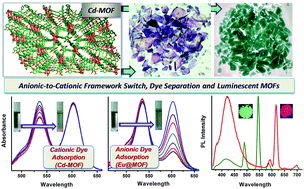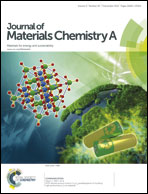Diverse isostructural MOFs by postsynthetic metal node metathesis: anionic-to-cationic framework conversion, luminescence and separation of dyes†
Abstract
An extremely flexible and robust anionic Cd–MOF – accessed with a tetraacid linker, viz., 3,3′,5,5′-tetrakis(p-carboxyphenyl)-2,2′,6,6′-tetramethoxy-1,1′-biphenyl – is shown to exhibit abundant postsynthetic metal exchange (PSME) of metal ion nodes with a number of metal ions that differ vastly in terms of their charges, ionic radii and chemical nature; as many as 16 isostructural new MOFs with transition, lanthanide as well as main group metal ions have been characterized with single crystal X-ray structures determined for 11 of them. The PSME allows unique conversion of the anionic framework structure of the Cd–MOF into a cationic one, when the divalent cadmium metal ions are exchanged by trivalent Ln(III) ions. The Eu@MOF and Tb@MOF, accessed by PSME of a transition metal MOF, are shown to be brilliantly luminescent. The switch-over in the charge characteristics of the framework with PSME has been judiciously exploited for the separation of organic dyes based on their charges. The comprehensive investigations illustrate the broad scope of PSME to access new functional materials that cannot be readily accessed.


 Please wait while we load your content...
Please wait while we load your content...